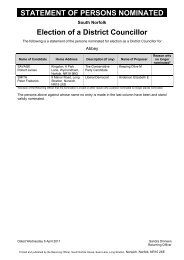Download the Transnational Ecological Network - South Norfolk ...
Download the Transnational Ecological Network - South Norfolk ...
Download the Transnational Ecological Network - South Norfolk ...
Create successful ePaper yourself
Turn your PDF publications into a flip-book with our unique Google optimized e-Paper software.
It is envisaged that this vision should provide afoundation for <strong>the</strong> various public agencies, landownersand local people with legitimate interests for managingthis area and making <strong>the</strong>ir living from it, to worktoge<strong>the</strong>r on a voluntary basis to recreate something ofwhat has been lost. Its implementation over time willlead to significant benefits for biodiversity in this part of<strong>Norfolk</strong> and Suffolk. Benefits will accrue to nationallytargeted biodiversity habitats such as floodplaingrazing marsh, reedbed, fen, wet woodland, standingwaters and small areas of lowland heath, and to anumber of species such as otter, water vole andmolluscs such as Desmoulin’s snail.OtterIt is not expected that <strong>the</strong> vision will become reality in ashort time. There is too much to achieve. Ra<strong>the</strong>r, if justa small part of <strong>the</strong> vision could be realised over <strong>the</strong>next ten to twenty years, that would representconsiderable success. Working collaboratively inpartnership with all interests should bring real benefitsfor all. Long-term programmes of work funded bypublic agencies could be integrated to deliver parts of<strong>the</strong> vision, bringing benefits for biodiversity and for <strong>the</strong>enjoyment of local people. There will be a redirection ofagricultural support systems in <strong>the</strong> course of time, andthis could contribute to this aim. This is alreadyoccurring, for example, through <strong>the</strong> Rural DevelopmentProgramme, which represents a significantredistribution of money for rural communityenhancement.We hope that local people, and especially those whoown <strong>the</strong> land, will be interested in some of <strong>the</strong> ideascontained in this vision. It would not be necessary foreveryone to ‘come on board’ at once, but someenthusiastic partners will be needed to get <strong>the</strong> task ofrestoration started. O<strong>the</strong>rs can join later. Works cannotgo ahead that would not be suppprted by thoseaffected by <strong>the</strong>m. We should like to know whatpotential ‘stakeholders’ think about <strong>the</strong> vision, andwhe<strong>the</strong>r <strong>the</strong>y may wish to contribute to its realisation infuture years. If <strong>the</strong>re is some enthusiasm for realising<strong>the</strong> vision, <strong>the</strong>n <strong>the</strong> responsible organisations will seekfunding from European and national sources to help toimplement it.Scarce chaser dragonflyThis vision has been prepared by Jeremy Pursegloveof Mott MacDonald on behalf of <strong>the</strong> Waveney and LittleOuse Partnership under <strong>the</strong> auspices of <strong>the</strong><strong>Transnational</strong> <strong>Ecological</strong> <strong>Network</strong> Project, and it hasbeen accepted by both <strong>the</strong> <strong>Norfolk</strong> and SuffolkBiodiversity Action Plan Steering Groups.3



![List of outstanding appeals against planning decisions [PDF, 30 Kb]](https://img.yumpu.com/51294693/1/190x135/list-of-outstanding-appeals-against-planning-decisions-pdf-30-kb.jpg?quality=85)

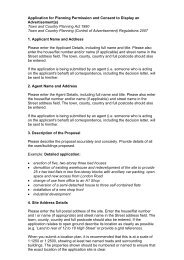
![Brown bin calendar - week 2 [PDF] - South Norfolk Council](https://img.yumpu.com/49352110/1/184x260/brown-bin-calendar-week-2-pdf-south-norfolk-council.jpg?quality=85)
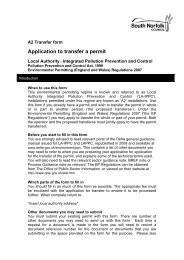

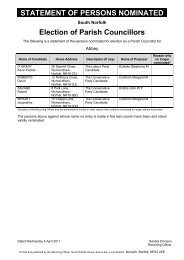
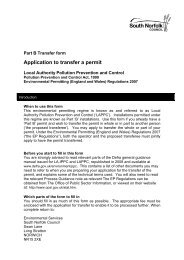
![Link magazine, Spring 2008 [PDF, 4,450k] - South Norfolk Council](https://img.yumpu.com/43994858/1/184x260/link-magazine-spring-2008-pdf-4450k-south-norfolk-council.jpg?quality=85)
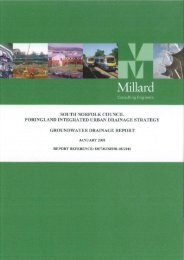
![South Norfolk Council Volunteering Opportunities [PDF]](https://img.yumpu.com/42079564/1/184x260/south-norfolk-council-volunteering-opportunities-pdf.jpg?quality=85)
![Tiffey Valley Guide [PDF, 1,450k] - South Norfolk Council](https://img.yumpu.com/41615145/1/124x260/tiffey-valley-guide-pdf-1450k-south-norfolk-council.jpg?quality=85)
![Queen's Diamond Jubilee Fund [PDF] - South Norfolk Council](https://img.yumpu.com/41088331/1/184x260/queens-diamond-jubilee-fund-pdf-south-norfolk-council.jpg?quality=85)
